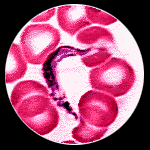

Trypanosoma:
Protista Sarcomastigophora Zoomastigophorea Kinetoplastida Trypanosomatidae TrypanosomaThese parasitic protozoa are tiny, single-cell organisms indigenous to Africa and South America. They cause some terrifying illnesses, including African Sleeping Sickness and Chagas' Disease.
There are two types of African Sleeping Sickness, corresponding to two different strains of this parasite: the Gamiense and Rhodesiense strains. Both types are carried by insects, such as tsetse flies. You will get the disease if an infected fly bites you, and it usually proves fatal. Gambian Sleeping Sickness results in a parasitic invasion of your nervous and lymphatic systems. Initial symptoms include fever, chills, and headaches, followed by weakness, apathy, and excessive sleepiness. Within a few years, the disease progresses to the point of coma, emaciation, and death.
Rhodesian Sleeping Sickness is even more serious. It involves an invasion of your cardiac tissue. The initial symptoms are mental depression, amnesia, and anemia. Death normally occurs within a year of infection.
The South American cousin of African Sleeping Sickness, called Chagas' Disease, is slightly milder. It arises from a strain of Trypanosoma that is carried by the cone-nosed bug. The disease is transmitted to humans via the excrement of these insects. You will become infected if you rub your eyes, scratch a bug bite, or in
some other way expose your internal tissue to parasite-laden cone-nosed bug excrement. This sounds awful, and it is. When introduced through the eye, Chagas' Disease causes massive swelling in the eyelid and face. This develops into swelling in the lymph nodes, liver, and spleen, resulting in headaches, fever, and anemia. Heavy infections of the cardiovascular system can lead to fatal heart failure.